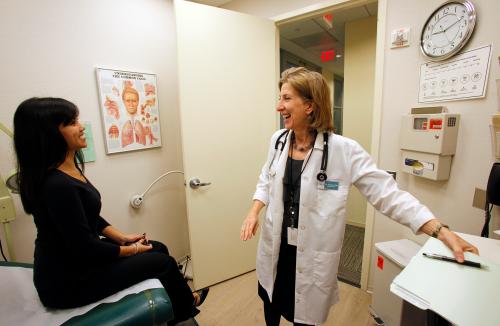In its most recent effort to increase the quality and curb the rising costs of the health care system, the Centers for Medicare and Medicaid Services (CMS) released the final rules of Medicare and CHIP Reauthorization Act, commonly known as MACRA, on October 14. Under MACRA, clinicians can choose to be a part of either an Alternative Payment Model (APM) or a Merit-based Incentive Payment System (MIPS). In both models, Medicare payments to clinicians are tied to some measure of quality and medical value. APM provides annual bonuses to clinicians, with the opportunity to earn more if they meet savings targets. MIPS rewards or penalizes its participants based on a set of self-reported measures. The majority of clinicians will automatically be enrolled in MIPS unless they choose to participate in APM. The rule exempts providers with less than $30,000 in Medicare charges or fewer than 100 unique Medicare patients per year, which according to the analysis by American Medical Association, includes about 30 percent of physicians. At least 642,000 clinicians are expected to participate in MIPS during the first performance year, which begins January 1, 2017.
Early experiments of APM have not been successful
While the effectiveness of the MIPS program is yet to be measured, pilot projects have been conducted to test the benefits of some of the APM models through the Pioneer Accountable Care Organization (ACO) model. As reported in two different studies in New England Journal of Medicine, the participants in the pioneer ACO projects could only archive very modest improvements in cost savings and patients’ experiences.
Contrary to the CMS claims that “ACO initiatives generated a combined total savings of $466 million,” analyzing the same data provided by CMS, Dr. Ashish Jha of Harvard concludes that rather than saving tax payers’ money, “CMS actually lost $216 million in 2015”. Other health policy experts have reached the same conclusions and warned CMS that by spinning early results, it may undermine the national efforts to reform payment models.
Note that the lackluster results present the best case scenario, achieved by those ACOs who were confidant and comfortable enough to participate in the pilot projects. When the program rolls out at the national level and organizations have to reluctantly participate despite their challenges with IT and health information sharing, data analytics, management and organizational structure, the results will be much worse.
MIPS cannot be successful
As I have previously discussed in details, MIPS program also suffers from several fatal problems. First, it allows physicians to choose the measures they prefer to report and thus renders impossible the meaningful comparison of physicians who report different sets of measures. Scoring physicians of identical medical specialty based on different measures is akin to comparing students’ performance based on different types of questions and exams.
Second, MIPS completely relies on self-reported measures without having any auditing system to detect and deter fraud. Given the significant financial incentives, some clinicians will inflate their reports, which further complicates the task of comparing physicians each other. What would happen if there were no IRS audits or no penalties for tax fraud?
Third, during the transition year of 2017, the penalties that were originally supposed to finance the bonuses to balance the budget will only be imposed on those clinicians who do not participate in the program. In other words, the first year clinical quality and cost savings are completely ignored and instead the mere participation in the program is rewarded. Incentivizing clinicians to participate in an untested and controversial program could be justifiable, but imposing a significant penalty on those who cannot participate in this program is absolutely unfair.
Fourth, in the interest of flexibility and reducing the reporting burden, MIPS only requires physicians to report six quality metrics. Medical care is extremely complex and its quality cannot be evaluated based on only six measures. To put this in perspective, note that Yelp provides data on 14 different features for evaluating a restaurant. Data that Yelp provides on restaurants today, are more comprehensive and reliable than what MIPS is supposed to provide for doctors one year from now.
The path forward
In the age of evidence-based policy making, data and facts should trump opinions and gut feelings. It is appalling that an agency such as CMS, which should be spearheading evidence-based rule making, is insisting on pushing either failed policies or untested ones that are destined to fail.
The common denominator in many of the failed policies of CMS over the last fifty years is the fact that the agency completely disregards patients and denies them the right to choose. Competition is the only tested and proven remedy for improvement in all industry sectors, yet an ill-structured market prevents competition in the health care industry. MACRA creates competition in the health care market, albeit in the wrong direction. Competition among medical providers should be focused on attracting patients by offering higher quality services at lower prices. However, in its current format, MACRA incentivizes providers to compete with each other to please CMS rather than directly offering value to the patients.
The primary reason for the lack of competition in the health care market is information asymmetry. To be able to choose, patients should have access to information about quality of the providers. Contrary to common belief, when provided with reliable information, patients make very wise decisions for their medical care. The results of the recent research by a group of highly respected health economists at Harvard, MIT, Columbia and University of Chicago shows that “higher quality hospitals have higher market shares and grow more over time. […] suggesting that patient demand plays an important role in [market share].” The impact is very large, for example, “hospitals with a 1 percentage […] higher survival rate from [heart attacks] have a 17 percent higher market share at a point in time and a 1.5 percentage point higher growth in market share over the next two years”. These effects are not limited to hospitals and are also observed at nursing homes: when CMS released quality metrics on nursing homes to the public, the market share of 1-star facilities decreased by 8 percent while the market share of 5-star facilities increased by more than 6 percent.
All of these effects are observed shortly after patients are provided with access to reliable information on the quality of medical care. CMS should take advantage of this powerful mechanism and focus on empowering patients and enabling them to choose by providing them with access to as much information as possible.
Specifically, in the MIPS program, CMS should focus its resources on creating reliable measures of quality and reporting it to the public. As long as the measures are comprehensive and reliable, patients will choose better providers, to compete, other providers have to truly improve their quality. This will happen without any direct incentive or change in the payment structure from CMS. In its current format, the quality measures are neither comprehensive, nor reliable. To fix that, CMS could consider the following suggestions:
1. Require more metrics on fewer patients
Rather than calculating a clinician’s composite performance score based on a few measures from the whole population of patients, compute the score based on all of the measures from a random sample of a few patients. Medical care is extremely complex. It is impossible to judge the quality of a surgeon’s work by relying on only six metrics. To reduce the burden of reporting, we should not limit the metrics, but we should reduce the number of patients for whom we report. As long as the sample is random and representative of the whole population of the patients that a specific physician sees, the estimated quality metrics will be reliable. This strategy will significantly reduce the reporting costs while providing a much more comprehensive picture of quality. To ensure that physicians do not self-select their “good” patients for their reporting purposes, CMS can ask for quality metrics on a random sample of its choice.
2. Establish an auditing system to detect and deter fraud
The success of the MIPS program hinges on ensuring the quality of reported data. The composite performance score cannot be trusted unless the data based on which the score is calculated is reliable. To ensure that the metrics reported by physicians are not exaggerated, CMS should establish a robust audit system akin to what is used by IRS to detect and deter fraudulent reports.
The Brookings Institution is committed to quality, independence, and impact.
We are supported by a diverse array of funders. In line with our values and policies, each Brookings publication represents the sole views of its author(s).











Commentary
MACRA final rule: Hype or hope?
October 25, 2016